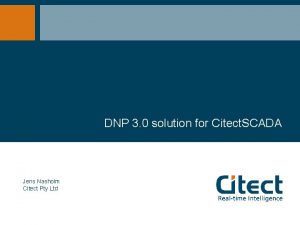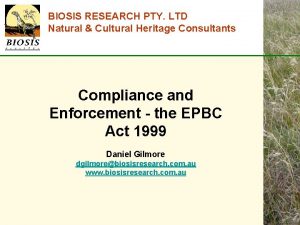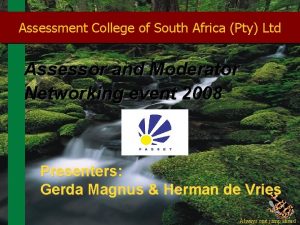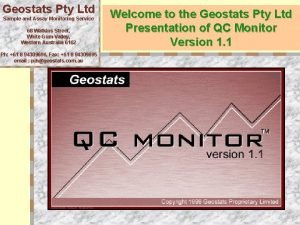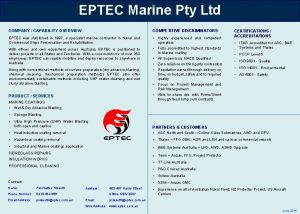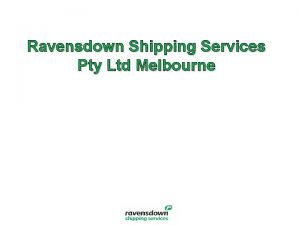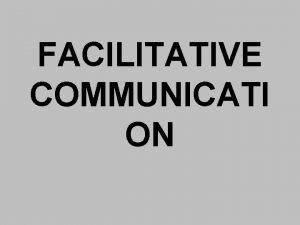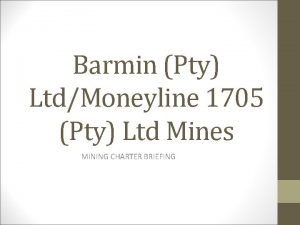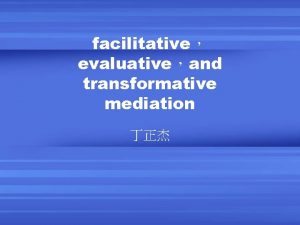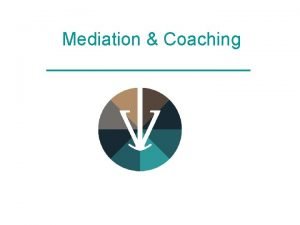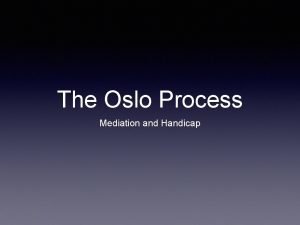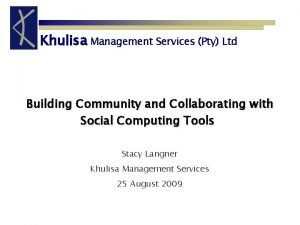Facilitative Mediation Process c Mediation Institute Pty Ltd











- Slides: 11

Facilitative Mediation Process (c) Mediation Institute Pty Ltd 2017 www. mediationinstitute. edu. au 1

1. Opening Statements Mediators Opening Statements 2. Agenda 3. Exploration Private Sessions: Equal time with each party. When depends on the mediation. 4. Option Generation 5. Negotiation 6. Agreement Mediators Closing Statements

Mediators Statement: Why and what Mediators Opening Statements • Your opening statements set the tone for the mediation, • Establish your authority over the room and the process, • Remind the participants about what will happen, roles and confidentiality • Gets their commitment to try and reach a resolution and to moderate their behaviour • Use your Agreement to Mediate, Run Sheet or Tick Sheet as a script to keep it professional, focused and fast. • Keep it short – 5 minutes maximum if you can and make sure you engage the parties • Use visuals if you can to demonstrate the process / timeline of the mediation (c) Mediation Institute Pty Ltd 2017 www. mediationinstitute. edu. au 3

Parties Statement: Why and what 1. Opening Statements • Gives each person in turn the chance to express why they are there, what the issues and how they are impacting their life and/or business • Your questions demonstrate how active listening is done • Your summaries check your understanding of the issues and help you to check out your agenda items • You should be reframing the issues to neutralise and checking the each party during the opening statements that you have it right. • You demonstrate your control of the room by managing outbursts and interruptions calmly and respectfully • You gain confidence in the parties by gaining rapport with the speaker without losing rapport with the listener • Take BRIEF notes to help you form the agenda. Your notes serve no other purpose so don’t allow not taking to prevent you from being engaged. (c) Mediation Institute Pty Ltd 2017 www. mediationinstitute. edu. au 4

Agenda: Why and what 1. 2. Opening Agenda Statements • Provides a framework and reminder to the parties about what they are there to resolve • Written in neutral and mutual language. This avoids polarisation and remember you are not trying to write up what you think is the solution to their issues • Chunk up abstract enough so that it each point is mutual – relevant to all parties • Check the agenda with the participants and allow them to suggest issues you have missed • Always have more than one agenda item. If you think that there is only one you are too abstract, chunk down into greater specificity • Invite the parties to negotiate the order so that you can observe how they negotiate. Don’t give criteria to them e. g “Which would you like to talk about first” not “Which is most important” • Thank them and congratulate them on how well they are interacting, respecting the ground rules and negotiating … something true that can set a tone of respect and appreciation. • Pick the “weaker party” to go first – you decide based on interaction, speaking ability, roles, relative positions or whatever your judgement decides. • Maintain control over the process – don’t let them begin exploration until you have the agenda agreed (c) Mediation Institute Pty Ltd 2017 www. mediationinstitute. edu. au 5

Exploration: Why and what • • • 3. 1. Opening Exploration Statements Provides an opportunity to clear up misunderstandings and misconceptions about each issue Goal is that each party understands and acknowledges the other persons point of view Get the parties to speak directly to each other Where you have to speak use summaries, reframes etc then throw the conversational ball back to the parties encouraging them to speak directly When you see a party reacting not responding ask them to summarise or explain their understanding or response to what was said, check that the meaning has been understood. If not ask the first speaker to repeat their point. It is OK if the parties move on to option generation don’t stop them If they begin going in circles or too much on the past use your agenda to refocus them or to move to the next issue Don’t be solution focused (at this point) focus on understanding and where possible acknowledgement of each persons perspective on the issue A good exploration phase will give your clients the tools they need to collaborate in reaching a resolution (c) Mediation Institute Pty Ltd 2017 www. mediationinstitute. edu. au 6

Private Sessions: Why and what 1. Opening Statements Private Sessions: Equal time with each party. When depends on the mediation. • Always get the agenda done first to make sure that there is no perception that you have breached confidential information from a private session • If they appear stuck or struggling emotionally take the session as needed but ideally after exploration • If they are communicating well encourage them to explore options before the private session - take notes of points of agreement but don’t try to lock them into an agreement at this point. • The parties can ask for a private session or you can. If you do be decisive, don’t allow your authority to be undermined by someone saying they don’t want the session • Briefly explain what will happen and how long you are planning for each session • Explain that it will be confidential and that you will not divulge anything they say without permission • Use the session to check in with how the mediation is going for them, any surprises they have had, any breakthroughs or movement towards a resolution they have found • If they are stuck ask them what the best or worst alternatives to reaching agreement are, remind them that they entered the process with the intention to resolve the dispute, check if a trial or other interim action could break the deadlock • If they are finding potential agreement reality test, ask them if they can see any potential problems with the solution and if so what protection or countermeasures they could plan • If they are having trouble speaking up ask them if they still feel safe to proceed, help them to rehearse what they want to say or as a last resort get their permission to raise the point in joint session • Keep the time equal and maintain confidentiality between sessions (c) Mediation Institute Pty Ltd 2017 www. mediationinstitute. edu. au 7

Option Generation: Why and what 4. Option Generation • Option generation shifts parties from their initial positions to consider other alternatives for resolving the issues • Help the parties to explain to each other why they think proposed options will or will not work • Help the parties to identify criteria for evaluating options if they are stuck • Use your whiteboard to list options and criteria (if appropriate) • Capture and acknowledge any points of agreement • This stage may occur naturally and quickly or may need overt facilitation to help the parties to consider more options • As a general rule the clearer the issues are (a good exploration stage) and the more options the parties have available to consider the more likely you are to find a solution that they can both live with rather than a compromise that no one is happy about • A clear problem statement to start option generation helps separate the people from the problem (c) Mediation Institute Pty Ltd 2017 www. mediationinstitute. edu. au 8

Negotiation: Why and what 5. Negotiation • Negotiation is about tying down the details of Who, What, When, Where and How the chosen option is implemented • Your job is to be the scribe capturing the detail as they speak and then confirming it with them • Be brave and reality test with them. Ask what could go wrong or prevent them doing what they propose. • Help them to imagine their chosen solution in the real world • If they are having trouble agreeing ask about trial periods, checking with advisors, if there is anyone else who will be impacted they need to check with • Write down what they have agreed during the negotiation (c) Mediation Institute Pty Ltd 2017 www. mediationinstitute. edu. au 9

Agreement: Why and what 6. Agreement • Capture potential points of agreement as you identify them without interrupting flow • Remind the parties about the points of agreement during the option generation / negotiation • Read through what you have written down as points of agreement again at the end ask if they want it written up for them • In some situations the agreement will be written up and signed on the day • Talk about how the agreement will be communicated to others and confirm their expectations with regards to confidentiality • Confirm who will do what e. g will you be sending a report / copy of the agreement to their employer or lawyer? • If no agreement is reached talk about next steps including a further mediation session or alternative process you can assist with or refer them to (c) Mediation Institute Pty Ltd 2017 www. mediationinstitute. edu. au 10

Mediators Closing Statements: Why and what Mediators Closing Statements • Congratulate the participants on their hard work • Congratulate them on their success if they reached agreement • Confirm what each participant including you will be doing next • Confirm the process if a further session is scheduled • Confirm confidentiality • Close the session • If there are safety concerns allow the vulnerable person to leave first and get clear before the other person leaves (c) Mediation Institute Pty Ltd 2017 www. mediationinstitute. edu. au 11


